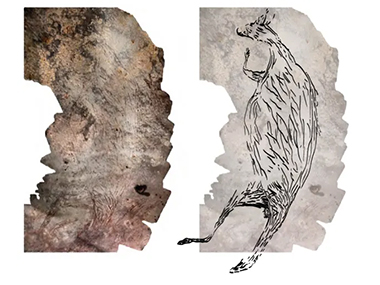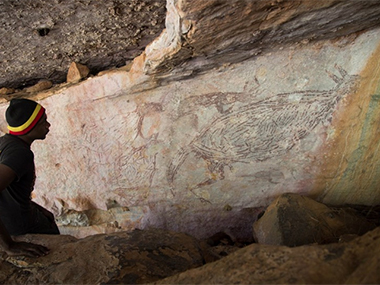ANTEDILUVIAN ROO

A montage of photographs of the 17,300-year-old kangaroo rock artwork in the Kimberley (left) and illustration of it (right). Photo: Damien Finch Illustration: Pauline Heaney
Jeremy Eccles | 05.03.21
Author: Jeremy Eccles
News source: Press Release
A 17,300-year-old painting on the ceiling of a rock shelter in The Kimberley's Drysdale River National Park, painted by ancestors of the Balanggarra Native Title group, the Miwa-speaking people, has been identified in the magazine, Nature Human Behaviour as the oldest-known rock painting in Australia.
Working with Traditional Owners from the Balanggarra Aboriginal Corporation, researchers from the University of Western Australia and University of Melbourne dated fossilised mud nests built by wasps to calculate the age of the two-metre long painting of a kangaroo with infilled decoration.
Using a pioneering radiocarbon dating technique on 27 mud wasp nests underlying and overlying 16 similar paintings in eight rock shelters, they found paintings of this style were produced between 17,000 and 13,000 years ago.
During this so-called Naturalistic period for art in The Kimberley, sea levels were a mighty 106 metres below today’s and The Kimberley coastline was about 300 kilometres further away, more than half the distance to Timor.
With these dates, the researchers can imagine the environment in which the artists lived 600 generations ago. For example, much of the Naturalistic period came towards the end of the last Ice Age when the environment was much cooler and drier than now. Aboriginal artists at this time mostly depicted kangaroos, fish, birds, reptiles, echidnas and plants, particularly yams. As the climate warmed, distant ice caps melted, the monsoon was re-established, rainfall increased and sea levels rose rapidly.
By the Gwion Gwion times, around 12,000 years ago, sea levels had risen to 55m below today’s. This would undoubtedly have prompted long-term changes to territories and probably disputes. And this was when painters depicted the highly decorated human figures, which used to be known as Bradshaw figures. While plants and animals were still painted, these so-called Erudite human figures were clearly the most popular subject.
Kwini Traditional Owner, Ian Waina said locals and visitors were all keen to know how old the rock art was. “It’s something that all tribes want to know — how old are our paintings?” Waina told ABC News. “And tourists always ask too, but many Aboriginal people have no idea. What we’ve done now with the scientists is open up the gate to find out.”
Balanggarra Aboriginal Corporation Chair Cissy Gore-Birch told the West Australian newspaper that partnerships are important in preserving First Nations histories and cultural identities. “It’s important that Indigenous knowledge and stories are not lost and continue to be shared for generations to come.” In this case, partnerships included Maria Myers of the Dunkeld Pastoral Co and the Kimberley Foundation Australia (now Rock Art Australia).
“The dating of this oldest known painting in an Australian rock shelter”, Gore-Birch continued, “holds a great deal of significance for Aboriginal people and Australians and is an important part of Australia’s history”.
The Naturalistic art style that was analysed at the national park is one of the oldest of six distinct phases of rock art paintings recorded in the Kimberley region, predating both the Gwion Gwion style and the later Wandjina style. The earliest art would have been pecked into the rocks. University of Western Australia archaeologist Professor Peter Veth was part of the rock art dating project. Veth told ABC News, “The art, those pigments, those markings are fixed in the sandstone, they’re surviving from the Pleistocene, from before 12,000 years ago. The fact that this [rock art] is right throughout larger parts of the Kimberley is truly breathtaking.”
URL: https://www.nature.com/articles/s41562-020-01041-0
Share this:
»  del.icio.us
»
del.icio.us
»  Digg it
»
Digg it
»  reddit
»
reddit
»  Google
»
Google
»  StumbleUpon
»
StumbleUpon
»  Technorati
»
Technorati
»  Facebook
Facebook
Contact Details

The rock shelter where the most ancient painting in Australia has survived for 17,300 years, with Ian Waina, Kwini TO
Further Research
News Tags: Balanggarra Aboriginal Corporation | Gwion Gwions | Jeremy Eccles | Naturalistic art | Rock Art Australia | The Kimberley | Wandjinas
News Categories: Blog | Feature | Industry | Magazine | News
News Archive
- 08.03.21 | PAPUNYA ART AT 50
- 05.03.21 | ANTEDILUVIAN ROO
- 19.02.21 | National Endowment for Indigenous Visual Arts
- 19.02.21 | lutruwita apology
- 17.02.21 | SONGSPIRALS TWIST AROUND SONGLINES
- 04.02.21 | FIRESTARTER
- 02.02.21 | A Design for Adelaide’s Aboriginal Cultures Centre
- 02.02.21 | A Design for Adelaide’s Aboriginal Cultures Centre
- 02.02.21 | The Boy from the Mish
- 15.01.21 | Indigenous Fashion Meets Country Road
- 11.01.21 | "Lost in Another Person's Culture”
- 08.01.21 | 'Him Proper Clever Man'
- 04.01.21 | Appreciating Mparntwe
- 21.12.20 | DYARUBBIN
- 14.12.20 | FOUR DAYS TO GO
Advertising

